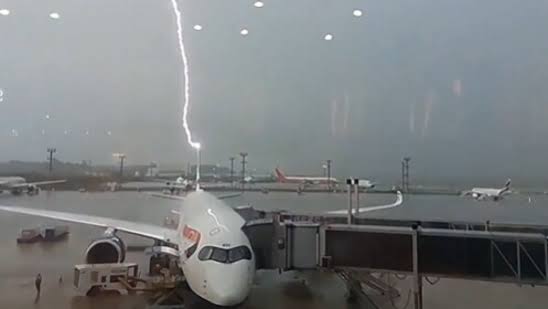British Airways Plane Struck by Lightning Mid-Flight
British Airways Plane Struck by Lightning Mid-Flight
A British Airways flight was struck by lightning mid-air, sending shockwaves among passengers but ultimately landing safely without any injuries. The incident, which occurred during a routine journey, highlights the impressive engineering of modern aircraft and the rigorous safety measures in place to handle such extreme weather conditions.
The Incident
The aircraft, a Boeing model operated by British Airways, was en route to its destination when it encountered a severe weather system. Witnesses on board reported a sudden flash of light followed by a loud bang as the plane was struck by lightning.
“It was terrifying for a moment,” said one passenger. “There was this bright flash outside the window, and then we heard a loud noise. But the crew remained calm, and everything seemed under control.”
Lightning strikes on aircraft, though dramatic, are relatively common and rarely pose a significant risk to modern planes. The conductive outer shell of an aircraft is designed to safely dissipate the electrical charge without affecting critical systems.
How Planes Handle Lightning Strikes
Aircraft are specifically designed to withstand lightning strikes, which occur more frequently than many people realize. According to aviation experts, commercial planes are struck by lightning approximately once a year on average. The last fatal lightning-related incident involving a commercial airliner occurred decades ago, thanks to continuous improvements in aircraft technology.
Planes are built with a conductive aluminum or carbon-fiber skin that allows electricity to pass safely around the structure and exit at designated points, typically the wingtips or tail. Electrical systems are heavily shielded to prevent disruptions, ensuring that essential controls, such as navigation and communication, remain functional.
“The aircraft essentially acts as a Faraday cage,” explained an aviation safety expert. “The electricity travels around the exterior and exits safely without harming the passengers or interfering with the plane’s operation.”
Passenger Reactions and Crew Response
Despite the unnerving experience, passengers onboard the British Airways flight praised the professionalism of the crew, who reassured them that the situation was under control.
“The captain made an announcement shortly after the strike, explaining what had happened and assuring us that the plane was built to handle it,” another traveler shared. “That helped calm a lot of nerves.”
British Airways confirmed that the aircraft underwent a thorough inspection upon landing to ensure there was no damage. “Our pilots are highly trained to manage such events, and our planes are designed to withstand lightning strikes,” a spokesperson for the airline stated. “Safety is always our top priority.”
A Common Occurrence in Aviation
While a lightning strike may seem like a rare and terrifying event, statistics show that commercial aircraft are well-prepared for such encounters. In fact, aircraft are often designed to trigger lightning strikes when flying through stormy areas, as their presence can disrupt the electrical balance in the atmosphere.
The last major aviation-related lightning incident occurred in 1963 when a Pan Am flight crashed due to a fuel tank explosion caused by a lightning strike. Since then, aircraft manufacturers have implemented measures to prevent fuel tank ignition, significantly reducing the risk of catastrophic events.
Today, lightning strikes on planes result in little more than a loud noise and a brief moment of alarm for passengers. However, airline maintenance teams still conduct thorough post-flight inspections to ensure there is no structural or electronic damage.
What to Do if Your Plane is Struck by Lightning
For nervous flyers, the idea of a lightning strike mid-flight can be unsettling. However, experts emphasize that there is no need to panic if such an event occurs. Here’s what passengers should keep in mind:
1. Stay Calm – The aircraft is built to withstand lightning, and pilots are trained to handle such situations.
2. Listen to the Crew – The cabin crew will provide updates and instructions if necessary.
3. Trust the Safety Systems – Modern aircraft have advanced safety features designed to dissipate electrical energy safely.
4. Expect a Post-Flight Inspection – Airlines routinely inspect planes that have been struck by lightning before clearing them for further flights.
Conclusion
The recent British Airways lightning strike incident serves as a reminder of the robustness of modern aviation technology. While dramatic, such occurrences are a normal part of flying and are handled seamlessly by aircraft systems and trained crews.
Passengers may have experienced a moment of fear, but thanks to engineering advancements and safety protocols, they continued their journey unharmed. For British Airways and the aviation industry as a whole, it was just another day in the skies—proof that commercial air travel remains one of the safest modes of transportation.






